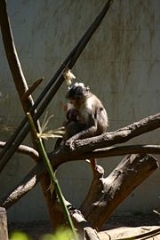
White-eyelid mangabey
Encyclopedia
The white-eyelid mangabeys are African Old World
monkey
s, belonging to the genus Cercocebus. They are characterized by their bare upper eyelids
which are lighter than their facial skin colouring, and the uniformly coloured hairs of the fur. The other two genera of mangabeys, Lophocebus and Rungwecebus, were once thought to be very closely related to Cercocebus, so much so that all the species were placed in one genus. However, it is now understood that Lophocebus and Rungwecebus species are more closely related to the baboon
s in genus Papio, while the Cercocebus species are more closely related to the mandrill
.
Old World monkey
The Old World monkeys or Cercopithecidae are a group of primates, falling in the superfamily Cercopithecoidea in the clade Catarrhini. The Old World monkeys are native to Africa and Asia today, inhabiting a range of environments from tropical rain forest to savanna, shrubland and mountainous...
monkey
Monkey
A monkey is a primate, either an Old World monkey or a New World monkey. There are about 260 known living species of monkey. Many are arboreal, although there are species that live primarily on the ground, such as baboons. Monkeys are generally considered to be intelligent. Unlike apes, monkeys...
s, belonging to the genus Cercocebus. They are characterized by their bare upper eyelids
Eyelid
An eyelid is a thin fold of skin that covers and protects an eye. With the exception of the prepuce and the labia minora, it has the thinnest skin of the whole body. The levator palpebrae superioris muscle retracts the eyelid to "open" the eye. This can be either voluntarily or involuntarily...
which are lighter than their facial skin colouring, and the uniformly coloured hairs of the fur. The other two genera of mangabeys, Lophocebus and Rungwecebus, were once thought to be very closely related to Cercocebus, so much so that all the species were placed in one genus. However, it is now understood that Lophocebus and Rungwecebus species are more closely related to the baboon
Baboon
Baboons are African and Arabian Old World monkeys belonging to the genus Papio, part of the subfamily Cercopithecinae. There are five species, which are some of the largest non-hominoid members of the primate order; only the mandrill and the drill are larger...
s in genus Papio, while the Cercocebus species are more closely related to the mandrill
Mandrill
The mandrill is a primate of the Old World monkey family, closely related to the baboons and even more closely to the drill. Both the mandrill and the drill were once classified as baboons in genus Papio, but recent research has determined they should be separated into their own genus, Mandrillus...
.
Species
- Genus Cercocebus
- Sooty mangabeySooty MangabeyThe sooty mangabey is an Old World monkey found in forests from Senegal east to Ghana. It is famous for being believed to be the monkey that HIV-2 might have originated in before jumping species...
, Cercocebus atys - Collared mangabeyCollared MangabeyThe collared mangabey , also known as the red-capped mangabey, white-collared mangabey , or cherry-crowned mangabey, is a species of primate in the Cercopithecidae family of Old World monkeys. It formerly included the sooty mangabey as a subspecies...
, Cercocebus torquatus - Agile mangabeyAgile MangabeyThe agile mangabey is an Old World monkey of the white-eyelid mangabey group found in swampy forests of Central Africa in Equatorial Guinea, Cameroon, Gabon, Central African Republic, Republic of Congo, and DR Congo. Until 1978, it was considered a subspecies of the Tana River mangabey . More...
, Cercocebus agilis - Golden-bellied mangabeyGolden-bellied MangabeyThe golden-bellied mangabey is a social Old World monkey found in swampy, humid forests south of the Congo River in the Democratic Republic of the Congo. It was previously considered a subspecies of the agile mangabey .-References:...
, Cercocebus chrysogaster - Tana River mangabeyTana River MangabeyThe Tana River mangabey is a highly endangered species of primate in the Cercopithecidae family. Some authorities have included the taxa agilis and sanjei as subspecies of this species, while others award these full species status.It is endemic to riverine forest patches along the lower Tana River...
, Cercocebus galeritus - Sanje mangabeySanje MangabeyThe Sanje mangabey is a highly endangered Old World monkey of the white-eyelid mangabey group from Tanzania. They are about 50-65 centimeters long, excluding tail, and weigh about 7-9 kilograms, and their body color is greyish. They live in valley forests, but are mostly ground-dwelling, which...
, Cercocebus sanjei
- Sooty mangabey

